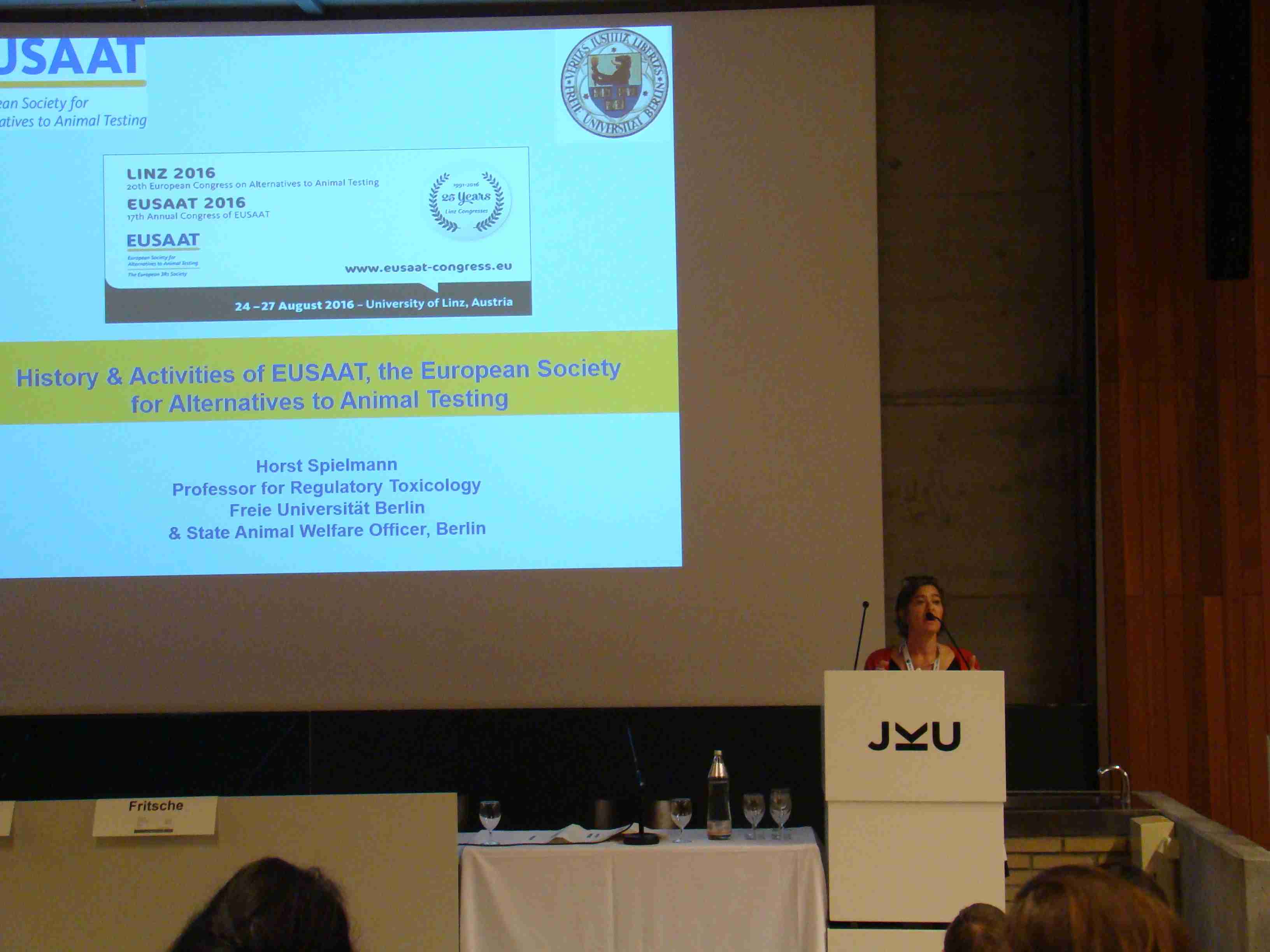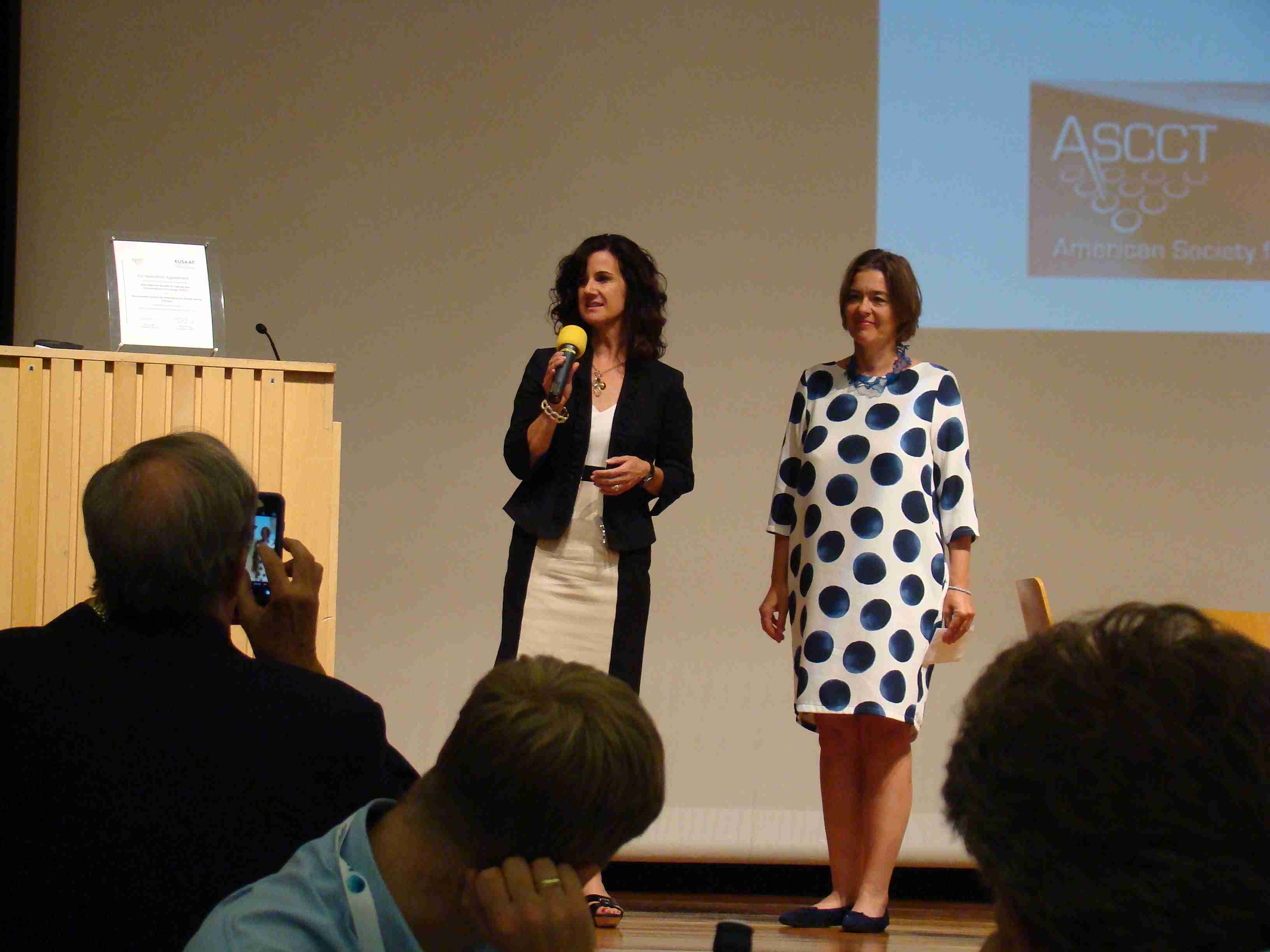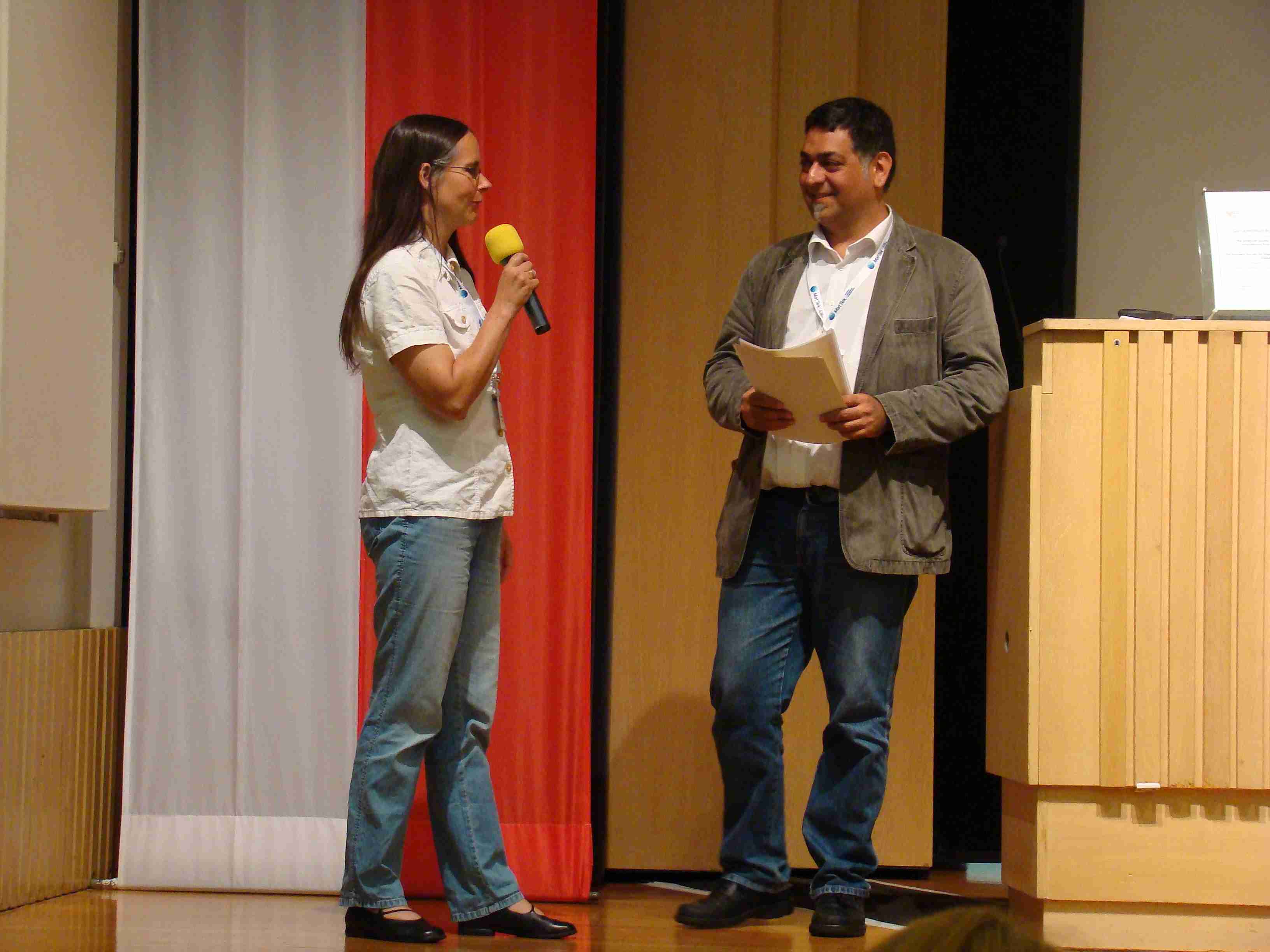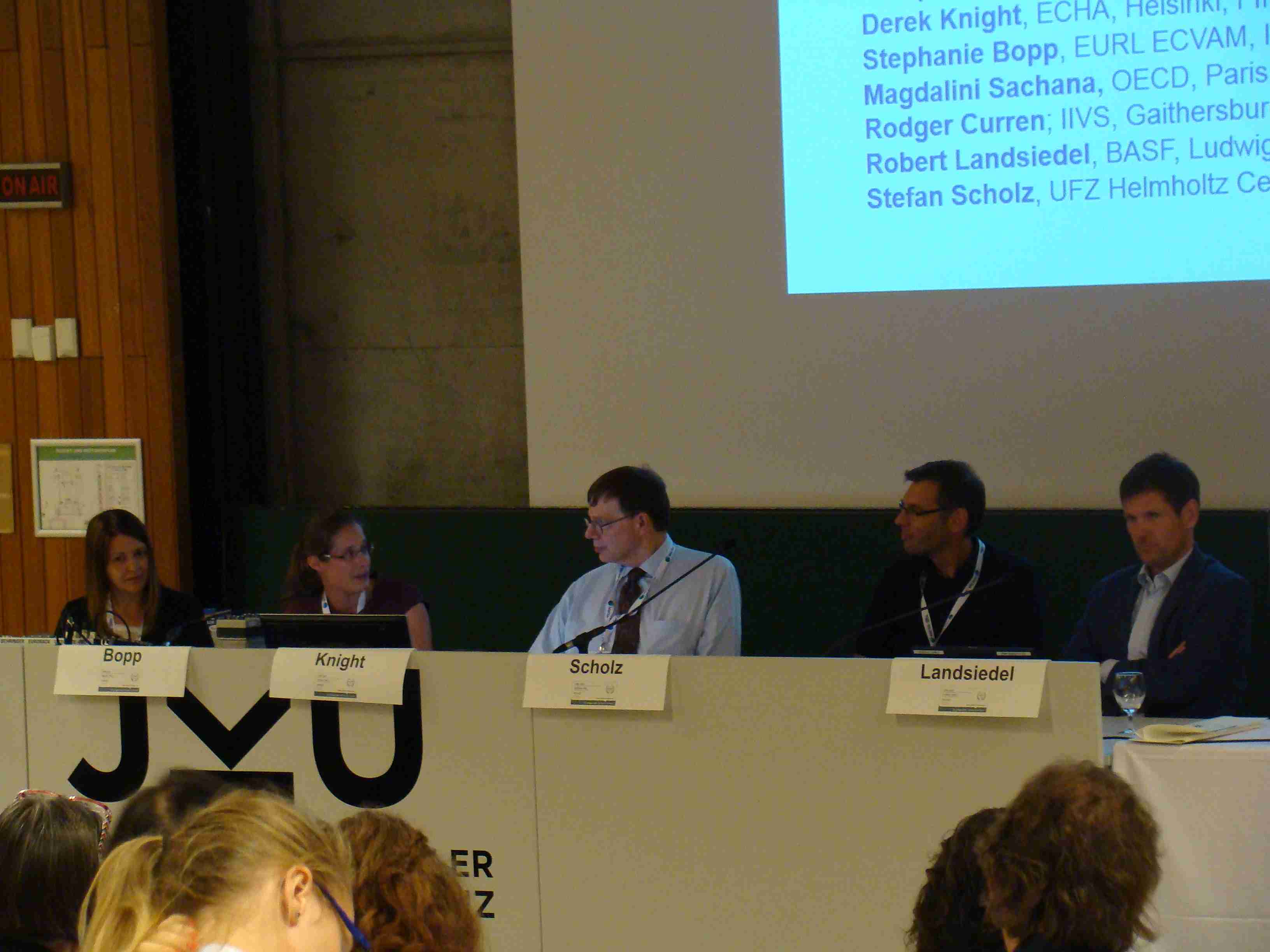307 research groups from 24 countries attended the Congress. The Congress is an opportunity for young scientists to gain experience in propagating and discussing their own research results. Prof. Dr. Ellen Fritsche, President of the European Society for Alternatives to Animal Testing (EUSAAT), stated in her welcome address speech that the EUSAAT Congress is the only one that covers the broad areas of 3R . Even after so many years, the Congress is still lively, and for the first time the subject “bioprinting” was represented, she said.

EUSAAT President Prof. Ellen Fritsche during her welcome address.
Photo: Christiane Hohensee
European-American collaboration agreement
Following the announcement on their collaboration by EUSAAT and the Japanese Society for Alternatives to Animal Testing (JSAAE) in 2015, the Europeans and the Americans – more precisely the American Society for Cellular and Computational Toxicology (ASCCT), represented at the Congress by the IIVS (Institute for in vitro Sciences) – agreed to collaborate as of this year.
Dr. Erin Hill from ASCCT and Prof. Ellen Fritsche from EUSAAT announce their close collaboration.
Photo: Christiane Hohensee
National committees and animal-welfare bodies: need for harmonisation
Dr. Susanna Louhimies from the European Commission in Brussels reported on the challenges involved in implementing the animal-welfare bodies and national committees according to Directive 2010/63/EU on the protection of animals used for scientific purposes: The animal-welfare bodies need management support in order to function. Competent staff need to install a “culture of care”, and employee participation is necessary in order to encourage staff to actively pursue animal welfare concerns, feel personally responsible and take initiative.
Dr. Justiyna Chmielewska, legal expert at the German Federal Institute for Risk Assessment (BfR), reported on the national committee in Germany, which has already conducted two workshops on determining the severity of tests on rodents and fishes. She pointed out difficulties implementing the European Directive, due to differences in long-term administration procedures in individual German federal states. This was also confirmed by Dr. Henning Steinicke from the Leopoldina in Halle (Saxony-Anhalt), who stated that regional differences in interpretation of the Directive and regulations led to problems implementing the Directive.
In Sweden on the other hand, the lack of consistency between the independently operating ethics commissions is subject to criticism. There are no “best practise” protocols for uniform decisions. To date the Swedish national committee has offered courses for the regional ethics commissions on the topics of ethics, pain and suffering.
Dr. Irmela Ruhdel from Eurogroup for Animals gave an overview of the current status of implementation processes in the European Member States, which she criticised as non-uniform. France, for instance, has no provisions for a retrospective ethical evaluation of animal tests. In addition she described the approval procedures for animal tests in the Member States are biased, as the approving authorities had a validation right but could not conduct their own ethical evaluations.
EU research projects must make do with less funding
Dr. Mardas Daneshian from CAAT Europe presented the planning for the new project cluster EU-ToxRisk. Although this cluster is currently the EU flagship in the field of alternatives to animal testing, the total funding to the tune of 30 million euros for 39 participating research groups is modest compared to the 220 million euro funding for its predecessor, Seurat-1.
Why animal tests have nothing to do with patients’ reality
Michael Liebman, computer scientist for biomedicine and founder of ipq analytics in Kennett Square, Pennsylvania, held a keynote address informing the audience about the “real world” of patients and medicine – a sphere beyond the reach of animal testing. He described disease as process and not a condition, with 55 per cent of all patients in the USA suffering five or more diseases (“comorbidity”). In addition, the metabolic pathways – regardless of whether they are identical in humans and animals – can nonetheless operate differently in different species. It is also entirely impossible to determine the kinetic parameters in a whole organism. He therefore regards animal models as neither a safe nor an efficient method for mapping the reality of patients’ situations.
One test for two toxins
Dr. Heike Behrensdorf-Nicol from the Paul-Ehrlich-Institut in Langen presented her BINACLE (BINding And CLEavage) assay for detecting minute amounts of tetanus or botulin toxins. This in vitro test does not require any cells and utilises the toxins’ ability to bind with specific receptor molecules on nerve cells and to cleave substrate proteins inside the nerve cells. In the test only the receptor molecules are placed on microtitre plates and introduced to the test fluid. The test is specific and highly sensitive, and it can save myriad guinea pigs each year from animal tests in the area of tetanus toxin testing, as well as 50,000 mice in botulin toxin tests. The research team was awarded the Ursula M. Händel Prize for animal welfare in research by the German Research Foundation (DFG) and also received this year’s ALTEX publication prize at the EUSAAT Congress.
Dr. Heike Behrensdorf-Nicol from the Paul-Ehrlich-Institut receives the ALTEX prize in the name of the whole team from ALTEX President Dr. Mardas Daneshian.
Photo: Christiane Hohensee
Validating test strategies: ECVAM and radio silence
A round-table meeting addressed the important topic of validating test strategies. In toxicology questions often cannot be answered with one in vitro test, but only with a series of tests, a so-called test strategy. This is the case for instance with the new replacement method for animal tests in the area of skin sensitisation, which comprises a series of three Tests (OECD Test Guidelines 442 C, D and 4E). The individual tests have now successfully passed the validation process, however the test strategy as such has not yet been approved. Thus the individual tests are mandatory, but not the sequence strategy that provides a defined combination of these tests. And that is necessary in order to obtain the required test results in the necessary quality.
Dr. Robert Landsiedel has worked on the development of replacement methods for animal testing at BASF for many years. In 2011 he already submitted an integrated test strategy (ITS) to the European validation authority ECVAM. “Then in 2014”, says Dr. Landsiedel, “IATA was invented” (Integrated Approaches to Testing and Assessment, for instance in the area of skin corrosion and irritation). This is a new approach that, as opposed to the concept of integrated test strategies, allows flexible single tests as building blocks for investigating the toxicity of a chemical, whereas the tests in an integrated test strategy are clearly defined. IATA seems to have ousted the ITS approach. And therein lies the problem: A validation with IATA is difficult because of the flexibility of the methods, according to Dr. Stephanie Bopp from the European validation authority ECVAM. In her presentation she stated that, at best, elements of IATAs can be validated.
Dr. Landsiedel pointed out that his ITS concept is not flexible and can therefore be validated. This was also applied for in 2011, but now most scientists refer to the IATA concept and no longer the ITS concept. However, this is not necessary for replacement methods already approved in the areas of eye and skin irritation and skin sensitisation, as ITS is sufficient to obtain conclusive results in these areas; but as long as the ITS concept has not been validated and adopted into the OECD Test Guidelines, the implementation of an integrated test strategy is not mandatory. If the individual tests do not provide conclusive results, the manufacturers may once again advocate conducting animal tests.
Round-table discussion on test strategies.
From left to right: Magdalini Sachana (OECD Paris), Dr. Stephanie Bopp (EVCAM), Dr. Derek Knight (ECHA Finland), Dr. Stefan Scholz (UFZ Leipzig), Dr. Roger Curren (IIVS) and Dr. Robert Landsiedel (BASF).
Photo: Christiane Hohensee
News on Ecotoxicology
Scientists at company Teco Medical have developed a non-invasive method for testing hormonally active substances (endocrine disruptors) in bodies of water. It has been known for many years that endocrine disruptors lead to a feminisation of fish or impair the reproductive capacity of male fish. For this reason scientists test substances with the Vitellogenin Test (see OECD Test Guideline 234). Vitellogenin is a precursor protein of egg yolk normally produced in female fish. Endocrine disruptors in water can, however, bind to oestrogen receptors in fish and thus also trigger vitellogenin synthesis in male fish. For this reason vitellogenin synthesis is used as a bio-marker for the presence of endocrine disruptors in water. According to the Test Guideline, blood or liver samples from Japanese rice fish, sticklebacks, zebrafish or minnows are used.
Instead of blood and liver samples, Teco Medical uses cotton swabs to take mucosa samples from the body surface of the fish, which are briefly taken out of the water and put back into the water immediately after the sample is taken. The sample analysis itself is conducted as usual using an ELISA test. The company is also working on an alternative to the so-called S9 fraction obtained from rat liver cells.
Humane disease models
Human “disease-on-a-dish“ models are always an interesting subject, because they cross over into the area of basic research and come closer to the goal of being able to simulate a systemic organism in vitro in the future. Also, countless animals are used for studying diseases. This year’s focus was on pulmonary diseases, with several prominent groups presenting new results:
Prof. Claus-Michael Lehr’s research team has developed a new human alveolar cell line that illustrates well the human in vivo blood-air barrier. Alveoli are the sacs in the lung responsible for the exchange of respiratory gases and are made up of two cell types, type I alveolar cells and type II alveolar cells. The model developed is made up of type I cells (type I cells are responsible for the blood-air barrier in the lung, whereas type II is responsible for pulmonary surfactant, surface proteins that reduce surface tension). The scientists successfully immortalised type I cells using a lentivirus. The cells form intercellular connections (tight junctions) with a high transepithelial resistance, which can be used to measure the effects of inhaled substances on the cells.
Research on cell cultures of deeper lung tissue is of greater significance, as surface layers usually use mucus and cilia to prevent inhaled substances or dust from reaching deeper layers and instead immediately transporting them out of the body. Insight into what happens when substances do penetrate this barrier or with regard to the effects of pharmaceutical drugs in deeper layers are urgently needed (see ALTEX 03/16).
Prof. Michaela Aufderheide from Cultex Laroratories and her team regularly exposed the air-fluid interface of a cell culture containing normally differentiated human bronchial epithelial cells to cigar smoke for a period of 10 days. They observed a reduction of ciliated and mucus-producing cells. At the end of the tests they also discovered metaplastic changes in the medial cell layer of the lung tissue.
Dr. Samuel Constant, CEO of the Swiss company Oncotheis, presented a new in vitro lung cancer model that uses human cells. It is called OncoCilAir and consists of pulmonary epithelial cells, human pulmonary fibroblasts and a pulmonary adenocarcinoma cell line. This combined tissue is viable for longer than three months. The model can be used to test the efficacy of cancer drugs against lung cancer cells or their possible harmful effects on healthy lung cells.
Refinement
This year’s topic, the refinement of animal tests, focussed on the assessment of the severity for animals subjected to tests. To this end the Federation of Laboratory Animals Science Association, the European Society for Laboratory Animal Veterinarians, the European College of Laboratory Animal Medicine and the German FELASA held a workshop for interested parties. A uniform European severity assessment is currently still being developed.
The Dutch medical centre Syrcle informed the audience as to the necessity of a systematic review before conducting animal tests. Such a review would lead to a more suitable choice of animals, provide more transparency and also help better assess severity.
Links:
http://eusaat-congress.eu/images/2016/Abstractbook_Linz_2016_EUSAAT_2016_low_res.pdf
